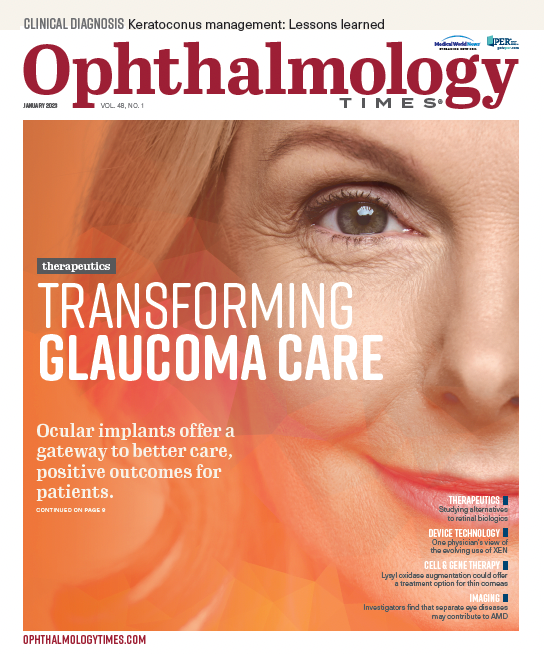Publication
Article
Digital Edition
XEN continues to evolve for use in glaucoma surgery
Author(s):
Patient-tailored techniques result in predicable outcomes for patients.
When the XEL Gel Stent was introduced, it was used as a less invasive alternative for patients facing trabeculectomy.

When the XEN Gel Stent (Allergan) was introduced, we began using it as a less invasive alternative for patients facing trabeculectomy. Over the years, many of us have done hundreds of XEN procedures, allowing us to become familiar with the device, develop a range of effective surgical techniques, and reach the best plans for follow-up care. As a result, in addition to patients who are eligible for trabeculectomy, we’re offering XEN to a broader range of candidates who can benefit from a predictable, long-term surgical treatment.
Today’s XEN candidates
I always keep XEN on the table when I’m examining patients who need surgery for glaucoma. For patients with uncontrolled pressure and potential damage to the optic nerve, XEN remains an alternative to trabeculectomy, offering the consistently low-pressure level we need for an easier recovery that does not include the restrictions we associate with trabeculectomy (no weight lifting, no swimming, no wearing contact lenses, etc). To choose a patient’s best option, I look at their pressure level, age, and lifestyle to balance their outcomes with their ability to keep doing what makes them happy.
I also consider XEN more often in younger patients with active lifestyles. They want a quick, predictable recovery. Choosing XEN earlier in the conversation does not preclude any future options for surgery because the tiny stent can be removed and has a small conjunctival footprint. Prior to XEN, these patients were relegated to selective laser trabeculoplasty, goniotomy, tubes, and trabs. XEN has added an additional step before more traditional and invasive surgical options for glaucoma.
To illustrate the versatility of XEN, I have had good results using it to treat patients with ocular hypertension and patients who experience steroid response. The latter have healthy optic nerves, so they may not need a pressure level of 10 to 12 mm Hg. However, because they need chronic steroids and are at risk for developing a pressure level spike, I want to get their pressure level to a range of 16 to 18 mm Hg. I find that XEN can predictably do that, and the patients require no other interventions or medications.
One patient of mine, a 40-year-old man with ocular hypertension, had frequent pressure level spikes due to his dexamethasone intravitreal implant (Ozurdex; Allergan). On maximum medical therapy (eye drop medications several times a day), his pressure levels were in the 40s. As a competitive triathlete, he spent hours swimming and training in the gym and outdoors and therefore could not find time to place his eye drops multiple times a day. We had a candid conversation about his options and expectations, and together we chose XEN. Two years later, his pressure level averages around 18 mm Hg with no medications. Stabilizing his pressure has helped his quality of life. In the past, we may have performed a trabeculectomy or a tube shunt for this patient. His recovery would have been long and arduous, and he may not have been able to continue his lifelong hobby of competing in triathlons. I felt good about helping him to have future injections safely without making a significant lifestyle change.
Expectations for recovery and needling
In my experience with XEN, we expect the pressure to be very low at day 1 and week 1 (about 8-10 mm Hg), and then we expect to see the pressure slowly climb as the body forms scar tissue. At 4 to 6 weeks, the pressure can spike to 20 to 22 mm Hg, at which time we can perform bleb needling. After 1 needling, the pressure typically remains in the low range of 12 to 14 mm Hg for years with no medications.
These well-established expectations and predictable outcomes are part of my initial conversation with patients about XEN, and they can be deciding factors. Some patients have anxiety because they want to control their pressure level but they’re having a hard time tolerating drops, and the idea of surgery makes them nervous. They want fast and predictable postoperative healing, and that’s a benefit of XEN. In rare cases, a patient doesn’t like the idea of a postoperative adjustment with needling, so we rule out XEN. This is why discussing postoperative bleb needling is an important part of my preoperative informed consent process.
Some surgeons, especially those new to XEN, are uncomfortable with postoperative needling because they see it as a sign of surgical failure. As we have become more comfortable using XEN, we now view intraoperative and postoperative needling as a normal part of the procedure that allows us to achieve a high success rate. Intraoperative needling ensures the stent is in a good position and there are no tenons obstructing the lumen. If needed, the second needling clears scar tissue from the left eye and restores flow.
Evolution of tailored techniques
XEN was introduced with an ab interno surgical technique, but an ab externo technique quickly became common. I now use both techniques to tailor customized surgery for each patient, which has improved my ability to achieve the best and most long-lasting outcomes with the same expectations for postoperative recovery.
In addition, I have added the step of intraoperative needling to the XEN procedure when it is done ab interno. This step has virtually eliminated the need for me to do needling soon after surgery. When the procedure is over, I know the stent is correctly positioned, clear of obstruction, and functioning.
Choosing a technique begins with preoperative assessment of the conjunctiva. I do the ab interno technique for most patients, including those who have a thin conjunctiva or very little tenons, because they face greater risk of conjunctival damage such as holes from suturing or manipulation. I go through the angle in the anterior chamber to inject XEN without manipulating the conjunctiva and tenons at all. It’s an almost blind procedure because we channel the needle through the sclera to deposit it subconjunctivally, and that can make placement less certain. I do 2 things intraoperatively to set myself up for success: I always place a traction suture so that I have good control of the globe, and I mark the tip of the XEN stent to ensure I have good visualization through the conjunctiva.
When I see a very thick conjunctiva or a lot of tenons, I know they can not only obstruct or prevent the XEN from sitting in the proper position during the ab interno approach but also migrate and create scar tissue over the XEN in the postoperative healing period. If I go with the ab internoapproach, there’s a good chance of failure or the need for significant postoperative manipulation. I prefer to go with the ab externo approach because I can clear up any scar tissue and make sure the XEN is free of the tenons to ensure success.
Patients with conjunctival scarring from previous ocular surgery benefit from an ab externo approach as well. With the ab interno approach, we have less control to avoid the areas with scarring. This can prevent the formation of a nice, diffuse bleb. The ab externo technique lets us break up any scar tissue, resect any problematic tenons tissue, or implant the stent in another location that may not be accessible internally. If I start an ab interno procedure and see a lot of thick tissue, I can change to the ab externoprocedure. This adds a level of flexibility that benefits my patients.
A procedure you can master
XEN has several unique benefits for patients to make it worth adopting, whether you do it yourself or refer candidates to a glaucoma specialist. Whether you want to expand your use of XEN or try it for the first time, don’t be afraid. It is easy to learn. My most important advice for new users is to discuss it with colleagues. Whether it’s new to you or you’ve done the ab interno approach and want to try the ab externoapproach, discuss it with your friends. Talk to them about your cases and spend time mastering the technique. Do one technique 20 or 30 times and then move on to the other. You’ll quickly be comfortable with postoperative care and develop a predictable pattern for lowering pressure levels for your patients.
Reena A. Garg, MD
Garg specializes in the medical, laser, and surgical management of glaucoma and cataracts at Visionary Eye Doctors in Rockville, Maryland. She also serves as the program director for the ophthalmology residency program at Medstar Washington Hospital Center/Georgetown University in Washington, DC.

Newsletter
Don’t miss out—get Ophthalmology Times updates on the latest clinical advancements and expert interviews, straight to your inbox.




